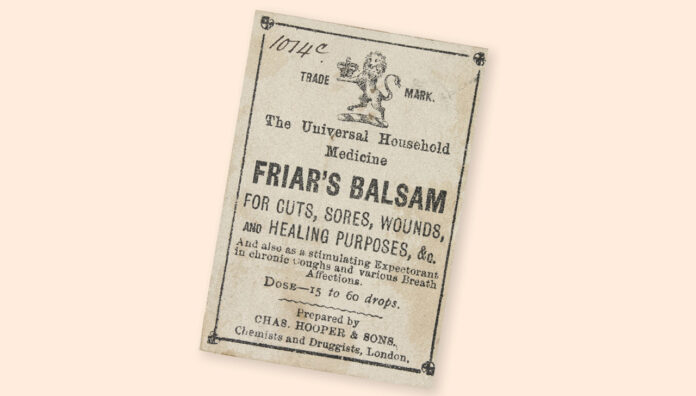From monasteries and battlefields to bathroom cabinets.
Like many simple remedies, Friar’s Balsam has a complex past.
For starters, the traditional herbal potion has many romantic names. Among them, Turlington’s Balsam, Wade’s Balsam, Jesuit’s Drops, St Victor’s Balsam, Persian Balsam, Swedish Balsam, Jerusalem Balsam, and of course Friar’s Balsam.
Its dullest contemporary name? Compound benzoin tincture.1
So who gets ‘inventor’ credit for this popular potion? Most freqently nominated is English parliamentarian and physician Joshua Ward (1684–1761). But given his reputation as a ‘quack doctor’, it’s likely Ward merely picked up the recipe while practising in France 1715–1734.2,4–7
And the origin of the French formula? Jerusalem, specifically the Saint Savior monastery. There, friar physician and pharmacist Antonio Menzani di Ciuna (1650–1729) developed the basic formula for Jerusalem Balsam. After he published his recipe in Milan in 1719 it was copied Europe-wide under numerous names.1,5
What’s in a name?
The key ingredient in modern balsam is benzoin.
A resin, this compound is extracted via cuts in trunks of trees in the Styrax family, a group of about 130 species that grow in warm or tropical areas.1,8,9 Another balsam basic is storax, an oily resin isolated from the bark of liquidambar trees. Also included is aloe, made from leaves of succulent plants like aloe vera and aloe ferox. Finally, it contains alcohol, usually ethanol.9–13 Of course, the amounts of the basics vary.11–13 The modern formula looks a little different to the four ingredients found in Menzani’s manuscripts: olibanum (frankincense), aloe, mastic and myrrh.5
Uses then
In 1946 archaeologist and priest Bellarmino Bagatti reported Swedish doctor and botanist Fredrik Hasselquist’s (1722–1752) observation that Jerusalem Balsam, aka Friar’s Balsam, was a multi-purpose ‘panacea’.
‘Given topically, it was used for healing of wounds of all kinds, bruises, and all skin disorders. Given systemically, it was used as a prophylactic in times of plagues, for treatment of stomach aches, worms, haemorrhoids, headaches, dizziness, ear and teeth problems, blood spitting, and cardiac disease.‘5,6
Moreover, the balsam was ‘used with equal success on horses, dogs and other creatures’, according to a November 1744 advertisement in a British newspaper.7
Uses now
Today, Friar’s Balsam is not recommended for the family pet … although it was nabbed as the name for a 19th century racehorse.
It is, however, found on pharmacists’ shelves worldwide, spruiked as a topical antiseptic and steam inhalant.1,4,11,13,18
The Therapeutic Goods Administration lists Gold Cross Friar’s Balsam as a single medicine product with permitted indications: ‘Decrease/reduce/relieve symptoms of common colds and flu. Antiseptic for minor cuts and abrasions.’12 While there is no solid science supporting many uses, Friar’s Balsam has also had some more unusual applications. Its sticky resin, for instance, has been exploited in the military and by athletes as a skin-toughening agent.
Last century, Friar’s Balsam was applied post-surgery as a protective film for mucous membranes. It has even been used during shoulder and amputation procedures.
Don’t look at the photos!1,13–17
References
- Manvi S, Sharma R. Tincture Benzoin in Dermatology. Journal of Medical Science and Clinical Research 2017;05(8):26154–8.
- Sedgwick RR. Ward, Joshua (1685-1761). The History of Parliament. The History of Parliament Trust 1964–2020.
- Westminster Abbey. Joshua Ward: physician and doctor. Dean and Chapter of Westminster. 2024.
- Museum of Health Care at Kingston. Friar’s Balsam (Compound Tincture of Benzoin).
- Moussaieff A, Fride E, Amar Z, et al. The Jerusalem Balsam: from the Franciscan Monastery in the old city of Jerusalem to Martindale 33. J. Ethnopharmacol 2005;101(1–3):16–26.
- The IK Workshop Society at The IK Foundation. iFACTS Fredrik Hasselquist. The IK Foundation & Company. 2024.
- Murden S. Dr Joshua Ward, the ‘Friar’s Balsam’ man. Georgian Medicine and Health. 2021.
- Benzoin – uses, side effects, and more. Therapeutic Research Faculty 2020.
- Grimshaw J, Bayton R, Elliott A. Styrax L. Trees and Shrubs Online. 2017.
- Storax – uses, side effects, and more. Therapeutic Research Faculty 2020.
- Friars Balsam 25ml. Alpha Vital 2024.
- Australian Government Department of Health and Aged Care. Gold Cross Friar’s Balsam (330993). 2020.
- Chemist Warehouse. Gold Cross Friars Balsam. Chemist Warehouse Virginia QLD.
- Benzoin Tincture Plain – uses, side effects, and more. Therapeutic Research Faculty 2020.
- Jeffery SL. Advanced wound therapies in the management of severe military lower limb trauma: a new perspective. Eplasty 2009;e28.
- Ray RK, Aung H, Corbett SA. Cost-effective traction for arthroscopic shoulder surgery. Open J. Orthop 2014;4(05):130–6.
- Scovil ER. Notes from the medical press. J Nurs 1913;13(9):703–5.
- Friar’s Balsam (horse). 2023.



 National Medicines Symposium 2024 speakers (L to R): Steve Waller, Professor Jennifer Martin, Professor Libby Roughead, Tegan Taylor[/caption]
National Medicines Symposium 2024 speakers (L to R): Steve Waller, Professor Jennifer Martin, Professor Libby Roughead, Tegan Taylor[/caption]


 This CPD activity is sponsored by Reckitt. All content is the true, accurate and independent opinion of the speakers and the views expressed are entirely their own.[/caption]
This CPD activity is sponsored by Reckitt. All content is the true, accurate and independent opinion of the speakers and the views expressed are entirely their own.[/caption]










